
Horsepacking in the Wakhan, where only 100-300 venture every year
By Bernadine Mynott
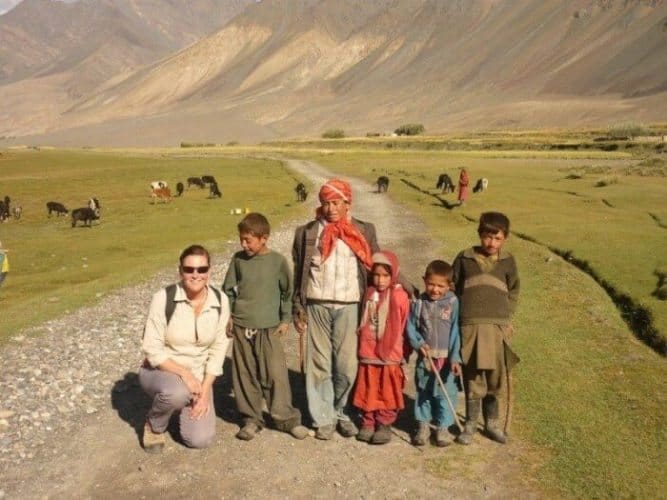
In late August 2015, I embarked on an incredible three-week adventure into the mountains of eastern Afghanistan, in the remote Wakhan Corridor and the Pamir Mountains.
The landscape was dramatic. The sheer scale of the mountains and the vastness of the valleys were exotic. I felt tiny in the enormous scale of it all.
I was heading into the farthest regions of Afghanistan, into a region fabled for centuries. The Wakhan has been virtually untouched by the wars that have torn the country for decades.
The Wakhan is a narrow strip of land, separating Pakistan from Tajikistan, and nudging China’s western border: wedged in between the giants of the Hindu Kush and the Pamir Mountains.
Only 100-300 international tourists visit the Afghan Wakhan corridor each year. In recent decades, more Westerners have summited Mt Everest than have seen Lake Chaqmaqtin; the furthest eastern point of Afghanistan, where I was to spend two days.
Here we go…

I landed in Dushanbe, Tajikistan at 3:00 am on Monday morning the 31 August.
Our small group of five (two Australians, two Americans and one German) were collected from the airport by a local Tajikistan driver.
With our luggage finally stacked high on the roof of the Land Cruiser, we piled into the seats to start the exhausting 4-day hot, dusty and uncomfortable four-wheel drive, to the start of the hike.
I gazed across the Tajik-Afghan border, over the majestic Panj River, blissfully distracted by the scenes only 300m away.
I watched people walking along dusty, brown dirt, donkey trails, and saw glimpses of the private domestic comings and goings of several Afghani families in and around their homes. The scenes seemed suspended in a different time: a bygone era.
The people who lived here had long been forgotten by the Western media and appeared to hold no interest to the Taliban.
Arriving at the border crossing town of Ishkashim, our driver unloaded the car, leaving us by the dirt highway, with our dust-covered backpacks by our side. We carried and dragged our luggage across the 300m bridge that spans the Panj River, framed by the majestic white crowns of the stunning Hindu Kush.
Afghanistan…
We sat in the Ministry Office for more than an hour. I recalled articles and interviews I had read and heard in recent months, and personal stories shared with me of the thousands of Afghani people who had set up refugee camps in the north-western corner of Pakistan in the 1980s.
I sat there in silence, reflecting on the rich and troubled history of the land and its people, and was thirsty to learn and immerse myself in more.
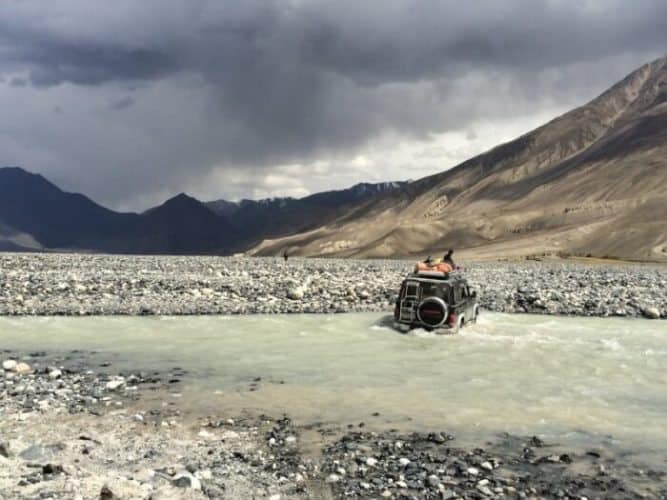
Inside the Ministry Office, we were led through a dim corridor and into a drab room at the back of the building. There were old, wooden school desks set around in a U-shape, where several men sat in dirty shirts and old trousers.
There were no computers. One man pulled a pair of scissors and a glue stick from a locked drawer under the desk, and trimmed the additional passport photos we had brought.
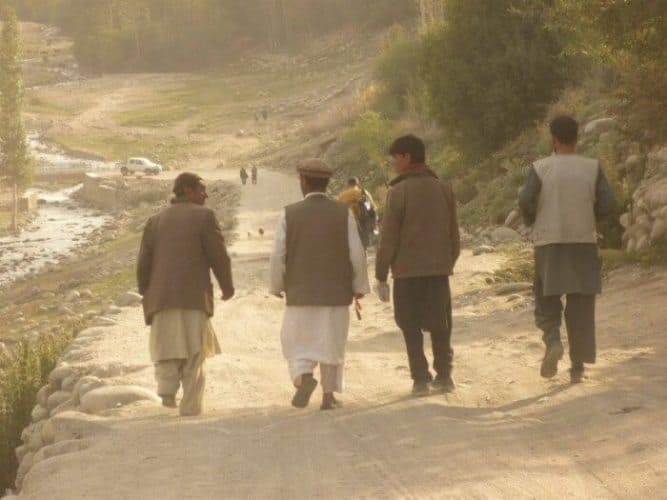
He opened one of the many well used A3 books, filled with passport photos, and hand-written entries of all who had traveled here before us.
The man stuck our newly trimmed photos precisely within ruled lines, on a page of one of the big A3 books.
These A3 books were a hand-written account of all the travelers that had entered Ishkasham in recent years. They were essentially the new Afghanistan history – at least in the Wakhan.
Meeting our horsemen
On day five, we arrived in Sarhad e Broghil (3,250m). From here, we would hike for 12 days, camping at night, and be completely self-sufficient.
I’m not a big fan of camping, and on the few occasions I’d previously tried it, I did not enjoy it. So I was apprehensive of my first night in the tent here in Afghanistan. Incredibly, I slept like a baby.
Nestled up against Pakistan, with the familiarity of the full moon looming over me, and comforted with the snow-capped mountains of the Hindu Kush by my side. I felt both remote, and peaceful.
Our group grew by six people, and eight animals, and included: 5 Afghani horsemen; 1 Afghani guide, 3 horses, 3 yaks, and 2 donkeys. The yaks would carry the heaviest of the supplies for the 12 days, including two large gas bottles, a couple of large cooking pots, a heavy-duty kettle, two satellite phones, and our heavy backpacks.
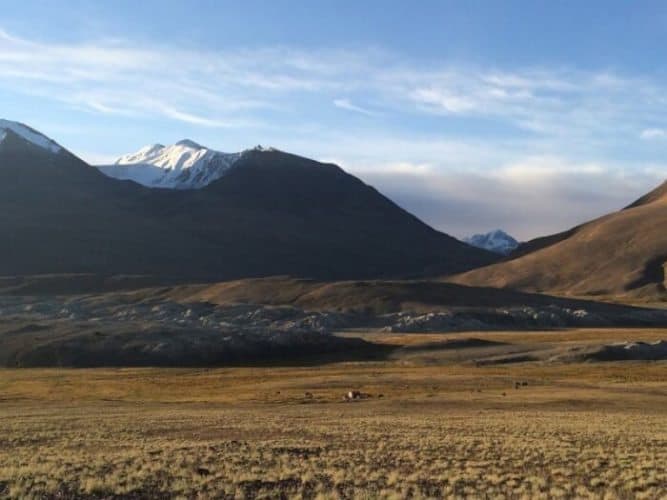
All the food had been purchased in Ishkashim and was distributed across all the animals, including; rice, potatoes, chickpeas, tinned tuna, flour (for bread), and boxes of teabags.
Also strapped onto these animals were tents and a number of other supplies for the trek.
Leaving Sarhad, we moved past fields, with women and men working, and children tending cattle.
The women working in the fields were dressed very differently from those I had seen in Ishkashim.
Back at the border town, the handful of women I had seen had been covered head to foot in mono-colored blue burkas.
The Wakhi people are Ismaili Muslims, where women are considered equals. In these villages, women wear beautiful red and purple patterned dresses, often complemented by multiple necklaces, earrings, bracelets, and brooches.
Their faces were never covered. Although I am a woman, in this part of the country, without the Taliban tentacles, I felt safe and welcome.
And off we walked…
The trail from Sarhad rises straight up, over paths of shifting shale, over the Pamir (Daliz) Pass at 4,260m. We walked for hours up steep, slippery sections of the mountains, and walked gingerly along old donkey tracks etched over centuries into the side of steep hills.
Our small group picked its way along these barely distinguishable tracks and false summits. Behind us, our horses moved softly on the hillside, with the shaggy-coated yaks surprisingly sure-footed behind them. The donkeys weighed down with supplies beyond their own body weight, were very comfortable on the narrow mountain paths.
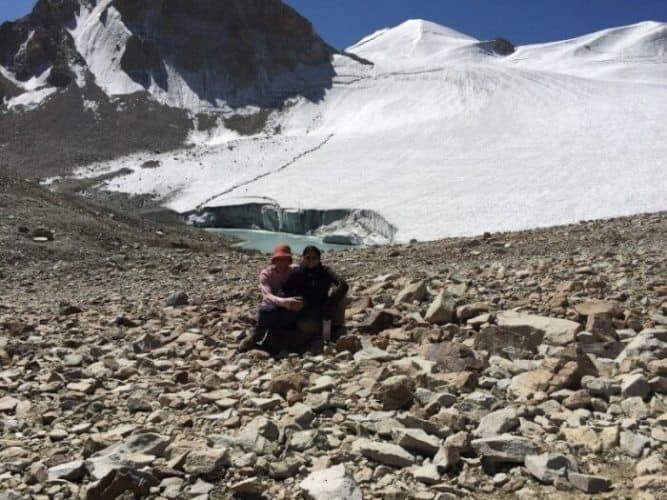
After five exhausting hours, we stopped for lunch, in a small valley with sweeping views across the mountains of northern Pakistan.
It was a tough and strenuous introduction to what the next two weeks had in store. We were hours behind where we should be according to the originally planned route.
Alternative campsites were discussed and our frustrated guide, tut-tutted at our slow pace.
The routine was the same each day: arrive at camp around 4 pm, unpack my tent, assemble my tent, set up my sleeping bag and backpack, and get ready for a hot cup of tea, which was always reliably ready around 4.30 pm.
Our horsemen were becoming less shy around us, and this allowed more interaction and helping each other with food, packing up the yaks, and generally sharing the journey. There was a good morning, every day as I woke before dawn, and a good night every evening as I climbed into my sleeping bag after dusk.
A Thin Layer
Like the horsemen, my skin and hair were now permanently covered in a thin layer of dust and dirt. Sometimes, when we arrived at camp a little earlier, I would head to the stream, to wash my face in the freezing water.
Other times, it was just a matter of washing clothing, including underwear, and draping it over the tent roof for an hour or two.
On day four, I went through the same routine. After setting up my tent, I spread out my sleeping bag and went to inflate my sleeping mat. But the metal valve on the mat was stuck shut, and no matter how hard I tried, my fingers couldn’t loosen the valve. I needed the insulating layer of my mat between my sleeping bag and the damp earth under the tent.

I put the metal valve between my teeth and tried to force it undone that way. I was biting down hard on the valve, and twisting it against the direction it was wedged shut.
Then…a Gentle Crack
Then – a gentle crack. The sound you do not want to hear, four days’ hiking from a vehicle or road. I looked down and saw a small piece of my tooth lying on the fabric of my trousers.
I picked the chipped tooth off my leg and shouted to others. I asked for superglue to put my tooth back together.
No one had any. I asked for a sleeping mat repair paste. But after we read the instructions, and saw this was a two-pack adhesive process, even I decided that was slightly excessive for a chipped tooth.
I was made to drink cold water, hot water, and all the time observed. After a while, it was decided the damage was superficial. I was going to have to put up with the serrated enamel edge around the chipped tooth until I got back to Australia.
My first shower at Lake Chaqmaqtin
It had taken us five hard days, trekking from a base of 3,250 at Sarhad to Lake Chaqmaqtin at 4,000m. I was filthy. Dust, sweat, and daily grit had built up as we’d ascended from Sarhad-e Broghil to the Lake.
Whilst we had only gained an overall altitude increase of 1,000m, we’d probably hiked a total ascent of about 3,000m with all the up and down each day.
We were at the end of the Little Pamir, looking from the far reaches of eastern Afghanistan to the western mountain ranges of China. Nestled here, in this corner of the world, with Tajikistan and Pakistan only days to our north and south, I felt dwarfed.
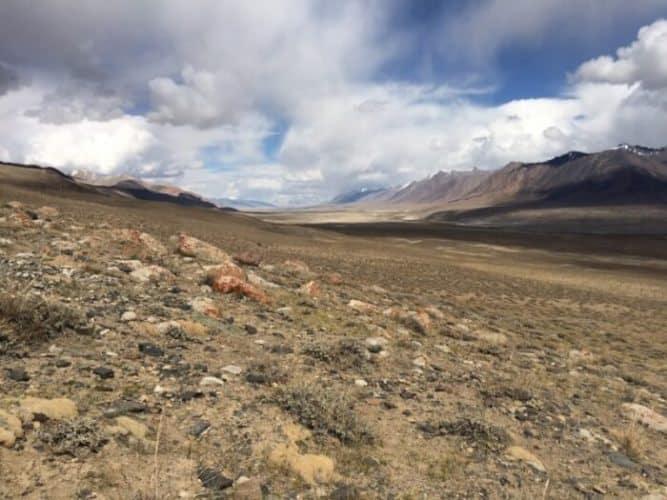
The great emptiness of the Pamirs spread around us, punctuated by jutting peaks. Some 700 years ago this Afghan district on the Russian border linked Orient and Occident. Great caravans of Marco Polo’s time inched their way across its craggy peaks.
This strip of no man’s land separating Russia from Pakistan was once the most direct route to the riches of the Indian subcontinent. The empty distance stretched ahead. The feeling grew on me, that we were the only people left in the world. I felt remarkably little and alone.
I was inspired to have a shower. In the middle of nowhere, a week from the nearest town, I could have simply pitched my tent, fluffed out my sleeping bag, inflated my sleeping mat, and lay down to rest.
But the horseman set up the shower tent, which up to this point I did not know we were traveling with. It was quickly erected, looking like a tall, green silk change room in the middle of these remote mountains. It stood about 2m high and about 1m square base.
Bathing
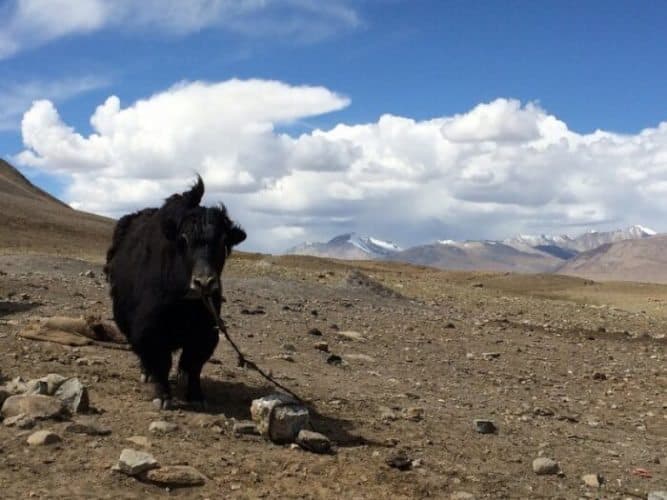
The horsemen filled the largest cooking pot with water they’d hauled from the edges of the lake, 400m away.
After it had boiled, the pot of hot water was carried by two men, and placed on the bare earth, inside of the shower tent.
Alongside the pot, an empty large bowl, an aluminum mug, and the kettle, full of cold water, were neatly placed on the dusty ground. There wasn’t much room left to stand.
Once inside, I realized the process of cleaning my matted hair, and grit caked face was not going to be as glamorous as I had imagined. The space I was standing in was barely bigger than me.
I was barefoot on the dirty ground. The gentle wind I’d be watching earlier was picking up outside, blowing the walls of the shower tent, so it flapped like sheets of paper.
I squatted down naked on my haunches, tipping my head upside down over the large bowl of warm water I’d mixed. I scooped and poured cup and after cup of deliciously warm, clean water over my matted hair. Upside down, I watched each cupful of water run out of my hair in the form of a gritty, grey liquid, onto the earth at my feet.
I repeated this a few times, then lathered shampoo, and rinsed and washed six days of filthy dirt and sweat, out of hair and scalp. I massaged conditioner into my hair and set about awkwardly washing and scrubbing my body. I half expected the tiny enclosure to be blown away at any point as the wind howled outside. Thankfully, the tent stayed upright, and I emerged; wet; clothed, and clean.
Snow, yak hair and Maggi noodle
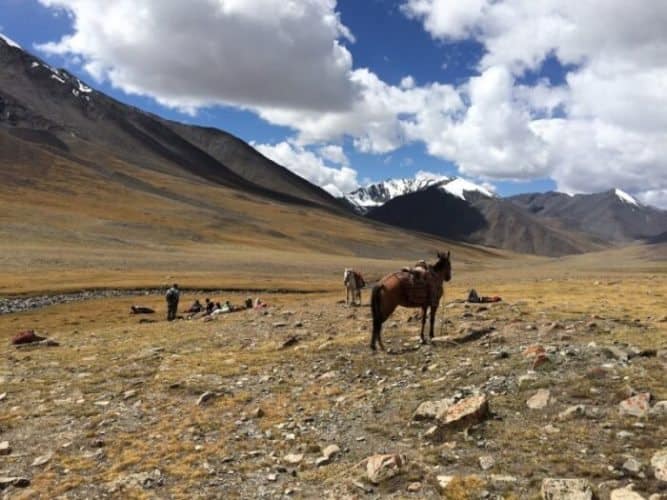
We moved from Lake Chaqmaqtina a few days later, to the Kyrgyz settlement of Bozai Gombaz at 4,100m.
We erected our tents amongst the herd of yaks, goats, donkeys, and dogs. Instead of kicking away rocks to flatten the ground to set up my tent, I kicked away donkey pats and picked up clumps of yak hair.
Shortly before dusk, light snow began falling. It landed on the dry earth, dusted the hides of the animals in the paddock, and sprinkled over our tents.
By morning, the cold had created a white, ice-encrusted coating over my tent, which made it annoyingly difficult to pack up.
On our seventh day of hiking, we moved over Aqbelis Pass (4,595 meters), the second highest crossing of the journey (the highest was yet to come). Once again my lungs screamed silently and breathlessly in pain. Although not the most strenuous day, the walking, altitude, and food were wearing me down.
We lunched on 2-minute Maggi noodles, and I was left calculating once again, how many calories I was losing that weren’t being replaced. My hands had been puffy for days, and my sinus and eyes were puffy.
I was constantly blowing my nose with traces of blood, but today was a day like the others. I needed to get through it because tomorrow was going to be hard work crossing the 4,887m high Uween-e-Sar Pass.
There’s still so much to discover
Our small group of ten walked, ate, and cooked together for 2 weeks. The horsemen and guides opened their sleeping room for us to share our meals together, drink many cups of tea when we were tired, stay warm together and share stories of family and home. The horsemen didn’t have their own personal space.
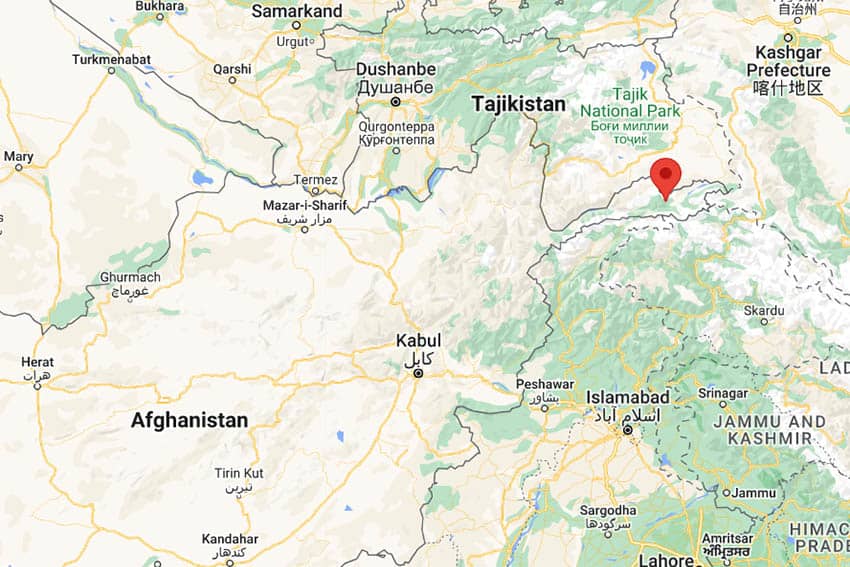
They slept on breadcrumb-filled horse rugs they set up every night after we’d finished eating in their sleeping room. They huddled closely together without down sleeping bags or fancy jackets. They sang beautiful Afghani songs that drifted across the few meters to my tent at night and had me nodding off to sleep smiling with grace at these men I was honored to walk with.
I had been windswept and sunburned, and sipped more cups of tea in two weeks than I had in my four decades before. The nights were bitterly cold. Although the food had been basic and delicious, it didn’t ever seem to provide enough calories. Dust had permeated every pore of my body.
Some thought me a courageous adventurer; others considered me foolhardy. I anticipated the trip would be challenging in many ways: hiking through the remote mountains over passes of 4,000-5,000m; camping; feeling overwhelmed; washing in rivers, and frequently way out of my comfort zone. I also knew I would feel alive with it all, in awe at what Mother Nature still had on offer to explore.

Bernadine Mynott is an Australian career woman, with a zest for life. Bernadine loves writing and embracing less pedestrian adventure destinations, including; Afghanistan, Bhutan, Norway, Turkey and sailing across Bass Strait.
- Saudi Arabia Might Be Your Next Getaway Spot - April 23, 2024
- Mongolia, the Land of Eternal Blue Sky - April 20, 2024
- These 9 U.S. National Parks Require Reservations in 2024 - April 17, 2024


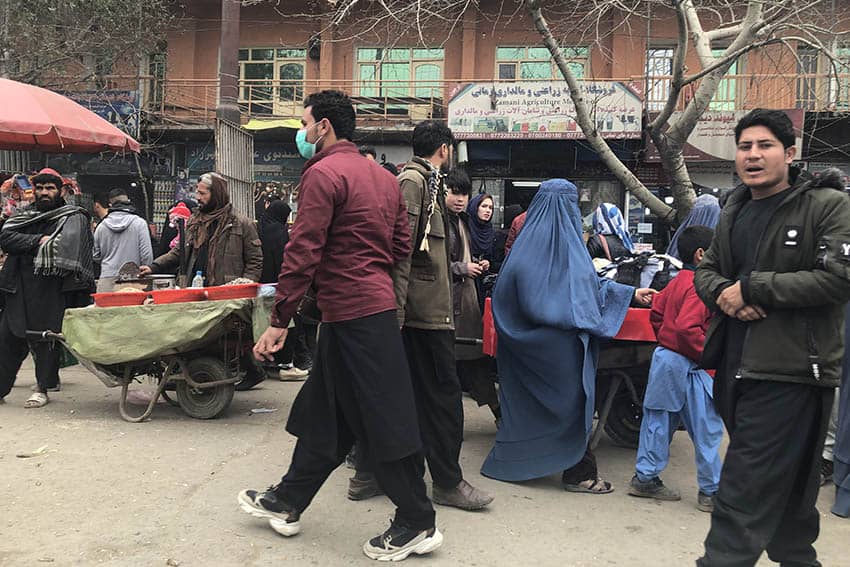
Hey! how much did the trip cost?
Hello Bernadine, thank you for much for sharing your trip in the Wakhan corridor. I am Bibilou of France/South Africa. I was adopted in by a Pakistani family in Pakistan Gojal in 1992. They descend from people who emigrated from Qazideh in the Wahkan corridor. I am curious to visit Wakhan and recreate the human link between the people. I have travelled regularly to Pakistan If you have any advice to share
Bibilou (Laurence Savary) My contact is +27823442601 bbl2savect@gmail.com
I see my message not answered. my request remains open for beenadine or others who travel in the Wakhan Corridor I am looking for useful contacts there.